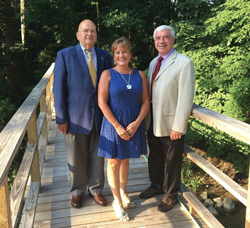Attempt to establish a conservancy district falls short
by Sheldon Ocker
The Yellow Creek Foundation’s mission to control periodic flooding and erosion along the Yellow Creek ended quietly more than four and a half years after petitioners asked a Summit County Common Pleas Court judge to establish a conservancy district.
When a Dec. 8 date loomed to post a $10,405 bond, directors of the Yellow Creek Foundation elected to withdraw their petition without prejudice (which means they can begin again if they choose), ending their effort to create a conservancy district in the Yellow Creek watershed. The watershed encompasses almost 32 square miles and includes parts of Akron, Fairlawn, Copley, Richfield Village, Richfield Township, Cuyahoga Falls, virtually all of Bath and portions of Granger and Sharon townships in Medina County.
In a letter to the editor to media outlets, foundation directors Brenda McShaffrey, Mark Spisak and James Stender outlined why they decided to end the fight.
“This past fall, we have been conducting a fund-raising campaign. While we have not met our goal, we were prepared to dig even deeper into our own pockets to post the bond. However, for practical reasons, not legal reasons, YCF has decided not to post the bond. … Although we have a strong case to present for district formation, even if we prevail, we would likely be burdened with years of subsequent legal battles from other entities involved.’’
The petition was being heard in the court of Kelly McLaughlin, the fourth common pleas judge to deal with the issue. McLaughlin’s order to post bond, satisfying a state requirement, was necessary to cover costs if the court (and Medina County judge Christopher Collier) failed to affirm the conservancy district.
Costs were divided into four categories: money to pay for notice of a public hearing ($5,300), hiring three deputies for security at the 3-day hearing ($2,900), court reporter expenses ($1,800) and copying charges for large maps ($405).
The petition to create a conservancy district generated opposition from eight of the nine affected communities, most of which hired lawyers. In addition, a grass-roots group of Bath residents, organized as the Citizens for Yellow Creek, actively campaigned against the conservancy district’s formation.
Opposition was based on the way conservancy districts operate. The judges who certify a conservancy district appoint a three-person board of trustees to oversee its activities. The board has two years to develop a plan of action and can levy up to .3 mill in property taxes to cover the cost of formulating their plan.
Once a plan is complete, the board can levy further taxes on property owners to execute projects targeted in the plan. A conservancy district also has the right of eminent domain. And because the board is appointed, there is no recourse to voters.
Answering these critics, the Yellow Creek Foundation letter states, “If the municipalities continue to put their own interests first, without regard to neighboring communities, the holistic conservation approach for which YCF is advocating is a lost battle.’’
The foundation’s campaign has centered on the proposition that environmental water issues involving the Yellow Creek can only be resolved if every affected community acts in concert.
The letter states that the foundation is not out of business and will “put funds to better use by following our mission to increase awareness and educate residents about best practices for the environment.’’
Since the petition to form a conservancy district was filed in April 2017, the Summit County engineer has instituted a program to address stormwater management. Any community can voluntarily join, but so far only Bath has done so. The cost to most residents is $48 per year.
Richfield Village property owners also pay a monthly fee to the Northeast Ohio Regional Sewer District for stormwater management. The fee is based on the amount of hard surfaces on a property. Business properties pay a higher fee than residential properties. ∞

